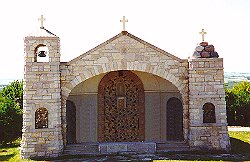

Throughout the years, the famous hill has had many names; in the aboriginal language it was known as Keespitanow Hill or Spathanaw Watchi (high hill). There are at least two versions as to how it has come to be known as Mount Carmel. One version believes that the name was given by the missionaries who used to travel by it along a prairie trail. The second version is that the name was given by Mr. and Mrs. McKay in memory of the Mount Carmel mentioned in the Old Testament and also in memory of their daughter, Hatty, who died nearby and was buried there in about 1872. Hatty, an Irish Catholic, had been ordered by her parents to marry a non-Catholic man. In order to avoid the marriage, she fled from home and escaped into the wilderness; then, either inadvertently or otherwise, she took poison and died. Isidor Dumas claims to have found her body and buried her northeast of the hill. Four or five years later, a skull showed above ground; a sign that the grave must have been shallow. But was there really a grave at the top of the hill? This seems to be a disputed question as the hill was leveled a bit in 1928 in order to lay a foundation for a pedestal for the statue of the Blessed Virgin Mary and no trace of a skeleton was found. However, none of these early events seem to have had any influence on choosing Mount Carmel as a pilgrimage site.
In 1902, exploration teams and the then future Abbot Bruno Doerfler were travelling through the proposed colony and stopped at the mount. They replaced a cross that had been placed at the top of the hill with a new one fashioned from the same poplar wood. On this occasion, it is believed that the site was already considered a good place for a pilgrimage. Father Bruno had conceived the idea of dedicating the mount to Mary but it was his successor, Abbot Michael Ott, who carried out the idea. On Sept. 10, 1922, Abbot Michael solemnly blessed the mount at a dedication ceremony which was attended by 3,500 people. It was on that occasion that it was announced the pilgrimage was to be an annual event to be held on the Sunday or following July 16, the feast day of Our Lady of Mount Carmel. He dedicated the entire territory of the abbacy to the Blessed Virgin.
The land on which Mount Carmel is situated was originally donated by an area farmer, John Bunko. Enough land was obtained for the chapel and about 15 more acres for parking. Originally, just an altar was erected on the hill's summit. Later a temporary chapel was built and it was moved down to the west slope where it is today. In the spring of 1928, the summit of the hill was leveled and an Italian made white carara marble statue of Mary, over 2.5 meters high, was made and placed on a foundation of native stone at the top of the hill. During the pilgrimage of July 28, 1928, the statue was solemnly blessed by Abbot Severin Gertken. Contributions toward a statue of Our Lady of Mount Carmel had come in gradually since an advocate of the Blessed Virgin from the Carmel parish had pledged $500 already in 1923. Special guests at the jubilee pilgrimage that year included Archbishop Michael O'Neill of Regina, Bishop Andrew Roborecki of the Ukrainian Catholic Eparchy of Saskatchewan, Bishop James Mahoney of Saskatoon, Archabbot Egbert Donovan of St. Vincent's archabbey of Latrobe, Penn. (St. Vincent's is the mother abbey of St. Peter's), Abbot John Eidenschink of Collegeville, Minn., and Fr. Waldemar Reschny, provincial of St. Mary's Province of Oblates, Saskatoon. To prepare for this occasion, a special workshop was conducted at the mount on July 15 by Dr. Alexander Peloquin of Boston College for the choir, cantors and instrumentalists; as well, several hundred people from surrounding parishes attended to practice the peoples' parts for the celebration the next day. They were also encouraged to "fan out" in groups of 10 among the crowd to help encourage the pilgrims' participation in the liturgy of the eucharist.
On Sunday, the celebration started with penitential services from 9:00-10:30 a.m. Preparation for the mass began at 10:30, and this gave the pilgrims time to practice their parts for the "Iyrical liturgy" (a mass composed by Dr. Peloquin). The eucharistic ceremony began at 11:00 with the procession of concelebrants and servers to the chapel. After the lunch break, the afternoon's agenda included the Stations of the Cross and the procession with the Blessed Sacrament.
[ Home ]
Please send comments to Carlton Trail REDA Inc.
![]()
Box10, Muenster, SK., S0K 2Y0![]()
[ The Humboldt Journal ][ Early Humboldt ]
[ St. Peter's Abbey | Agriculture | Communities ]
[ Present-day Humboldt and Surrounding Communities ]
[ Language ]
![]()